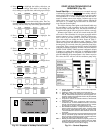
Chiller Dehydration — Dehydration is recommended
if the chiller has been open for a considerable period of time,
if the chiller is known to contain moisture, or if there has
been a complete loss of chiller holding charge or refrigerant
pressure.
Do not start or megohm test the compressor motor or
oil pump motor, even for a rotation check, if the chiller
is under dehydration vacuum. Insulation breakdown and
severe damage may result.
Dehydration is readily accomplished at room tempera-
tures. Use of a cold trap (Fig. 29) may substantially reduce
the time required to complete the dehydration. The higher
the room temperature, the faster dehydration takes place. At
low room temperatures, a very deep vacuum is required for
boiling off any moisture. If low ambient temperatures are
involved, contact a qualified service representative for the
dehydration techniques required.
Perform dehydration as follows:
1. Connect a high capacity vacuum pump (5 cfm
[.002 m
3
/s] or larger is recommended) to the refrigerant
charging valve (Fig. 2A or 2B). Tubing from the pump to
the chiller should be as short and as large a diameter as
possible to provide least resistance to gas flow.
2. Use an absolute pressure manometer or a wet bulb vacuum
indicator to measure the vacuum. Open the shutoff valve
to the vacuum indicator only when taking a reading. Leave
the valve open for 3 minutes to allow the indicator vacuum
to equalize with the chiller vacuum.
3. Open all isolation valves (if present), if the entire chiller
is to be dehydrated.
4. With the chiller ambient temperature at 60 F (15.6 C) or
higher, operate the vacuum pump until the manometerreads
29.8 in. Hg vac, ref 30 in. bar. (0.1 psia) (–100.61 kPa)
or a vacuum indicator reads 35 F (1.7 C). Operate the
pump an additional 2 hours.
Do not apply greater vacuum than 29.82 in. Hg vac
(757.4 mm Hg) or go below 33 F (.56 C) on the wet bulb
vacuum indicator. At this temperature/pressure, isolated
pockets of moisture can turn into ice. The slow rate of
evaporation (sublimination) of ice at these low temperatures/
pressures greatly increases dehydration time.
5. Valve off the vacuum pump, stop the pump, and record
the instrument reading.
6. After a 2-hour wait, take another instrument reading. If
the reading has not changed, dehydration is complete. If
the reading indicates vacuum loss, repeat Steps 4 and 5.
7. If the reading continues to change after several attempts,
perform a leak test up to the maximum 230 psig
(1585 kPa) pressure. Locate and repair the leak, and re-
peat dehydration.
Inspect Water Piping — Refer to piping diagrams pro-
vided in the certified drawings, and the piping instructions
in the 19XL Installation Instructions manual. Inspect the
piping to the cooler and condenser. Be sure that flow direc-
tions are correct and that all piping specifications have been
met.
Piping systems must be properly vented, with no stress on
waterbox nozzles and covers. Water flows through the cooler
and condenser must meet job requirements. Measure the pres-
sure drop across cooler and across condenser.
Water must be within design limits, clean, and treated
to ensure proper chiller performance and reduce the
potential of tubing damage due to corrosion, scaling, or
erosion. Carrier assumes no responsibility for chiller dam-
age resulting from untreated or improperly treated
water.
Check Optional Pumpout Compressor Water Pip-
ing —
If the optional storage tank and/or pumpout system
are installed, check to ensure the pumpout condenser water
has been piped in. Check for field-supplied shutoff valves
and controls as specified in the job data. Check for refrig-
erant leaks on field-installed piping. See Fig. 27 and 28.
Check Relief Devices — Be sure that relief devices
have been piped to the outdoors in compliance with the lat-
est edition of ANSI/ASHRAE Standard 15 and applicable
local safety codes. Piping connections must allow for access
to the valve mechanism for periodic inspection and leak
testing.
19XL relief valves are set to relieve at the 300 psig
(2068 kPa) chiller design pressure.
Inspect Wiring
Do not check voltage supply without proper equipment
and precautions. Serious injury may result. Follow power
company recommendations.
Do not apply any kind of test voltage, even for a rota-
tion check, if the chiller is under a dehydration vacuum.
Insulation breakdown and serious damage may result.
1. Examine wiring for conformance to job wiring dia-
grams and to all applicable electrical codes.
2. On low-voltage compressors (600 v or less) connect
voltmeter across the power wires to the compressor
starter and measure the voltage. Compare this reading
with the voltage rating on the compressor and starter
nameplates.
3. Compare the ampere rating on the starter nameplate with
the compressor nameplate. The overload trip amps must
be 108% to 120% of the rated load amps.
4. The starter for a centrifugal compressor motor must con-
tain the components and terminals required for PIC
refrigeration control. Check certified drawings.
5. Check the voltage to the following components and
compare to the nameplate values: oil pump contact,
pumpout compressor starter, and power panel.
Fig. 29 — Dehydration Cold Trap
47


















